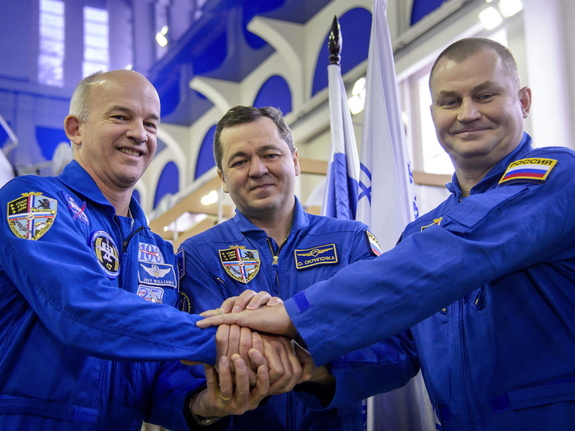A Russian Soyuz rocket launched a joint U.S.-Russian crew to the International Space Station Friday (March 18), a space team that includes an astronaut aiming to break an American spaceflight record recently set by NASA’s year-in-space astronaut Scott Kelly.
American astronaut Jeff Williams of NASA and cosmonauts Oleg Skripochka and Aleksey Ovchinin of Russia’s Federal Space Agency (Roscosmos) launched toward the space station at 5:26 p.m. EDT (2126 GMT) from the Baikonur Cosmodrome in Kazakhstan. The trio, riding in a Soyuz space capsule , arrived at the space station after a 6-hour journey, with their spacecraft docking at 11:09 p.m. EDT (0309 GMT on March 19), according to a NASA update. [Watch tonight’s Soyuz launch in this video replay ]
Finally, at 12:55 a.m. EDT Saturday (0455 GMT), the two crews opened the hatches between the Soyuz and space station, allowing the three new crewmembers to join American astronaut Tim Kopra, British astronaut Tim Peake and Russian cosmonaut Yuri Malenchenko in the giant orbiting lab.
.@Astro_Jeff on 3rd #Soyuz ride to space. You can see the pink owl talisman swaying as rocket soars into space. https://t.co/fSwINzYznI
— Intl. Space Station (@Space_Station) March 18, 2016
“The Soyuz TMA-20M spacecraft [is] now safely in orbit, Jeff Williams, Aleksey Ovchinin and Oleg Skripochka on board and ready to chase down the International Space Station,” NASA spokesman Dan Huot said just after the launch.
“In four windows I can see the Earth,” one of the cosmonauts told Mission Control as they rose.
The six-month space station stay will be Ovchinin’s first flight to space and Skripochka’s second, but Williams is a spaceflight and space station veteran. Williams is visiting the station for a fourth time; his first time was more than 15 years ago via the space shuttle Atlantis while the station was still under construction. While he’s in space, he will break Scott Kelly’s new record of the most cumulative time in space by an American.
By the end of Kelly’s recent near-yearlong mission (he landed March 1), the astronaut racked up a lifetime total of 520 days in space. On this new mission, Williams, who is making a record third long-duration stay on space station, should reach 534 cumulative days once he returns to Earth in six months. He will have spent time in space with at least 50 other space explorers, Williams said .

American astronaut Jeff Williams and Russian cosmonauts Oleg Skripochka and Alexei Ovchinin launched to the International Space Station March 18 from the Baikonur Cosmodrome in Kazakhstan. Here, they posed before their Soyuz qualification exams Feb. 24.
Credit: NASA/Bill Ingalls
Credit: Karl Tate, Space.com Infographics Artist
“The first time I was there [was] before Expedition 1, and I was there in Expedition 13, about halfway through the assembly [of the International Space Station]. And the last time was Expeditions 21 and 22, right at the end of the assembly,” Williams told Space.com in a video interview during a break from training in February. “I plan on taking the opportunity to refresh the world on what an adventure it’s been building the space station, and what an achievement it’s been in terms of human accomplishments in the history of human exploration.”
Next week, an Orbital ATK Cygnus cargo spacecraft will launch to the station, bringing supplies, spacewalking gear and new experiments for the six crewmembers to conduct. During the expedition, the crewmembers will look into spaceflight’s effect on the musculoskeletal system, how tablets dissolve in microgravity and the effectiveness of extra-small exercise equipment, NASA said in a mission summary . (The three new arrivals will stay on for both Expedition 47 and Expedition 48.)
When not occupied by experiments or exercise, Williams will be taking the opportunity to add to his (already substantial ) space photography, seeking out alternate views of places he’s seen over his 15 years of spaceflight.
“I do have a long list of targets that I want to try to get again, maybe in a different way, catch in different lighting conditions,” he told Space.com. “The equipment we have on board now is far advanced from what it was before, when I was there last, particularly for night photography. So I want to try to add to my collection some good night photography.”
Email Sarah Lewin at slewin@space.com or follow her @SarahExplains . Follow us @Spacedotcom , Facebook and Google+ . Original article on Space.com .

Comments are closed.